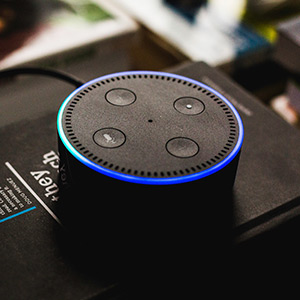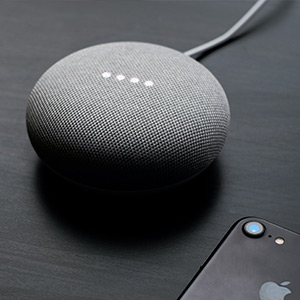


SEO for voice search
19/11/2020
Voice search is seeing exponential growth, with the market for voice search devices expanding by nearly 200% in the past couple of years. By 2022, it has been projected that voice-based shopping will lead to an estimated £30 billion worth of sales. Ensuring your website is voice-search friendly is fast becoming an integral part of any comprehensive SEO strategy.
A recent study by Google found that just over a quarter of the population of the world is actively using voice search – over 2 billion people. These kinds of figures highlight just how important it is becoming to ensure your digital content is easy for search engines to find as well as optimised for voice searches.
What is voice search?
 Voice searching works using Artificial Intelligence (AI) to interpret what you are saying and provides the most accurate responses to your questions possible. Whilst the technology has been evolving steadily over the past decade, it has now developed to a point where voice search is rapidly becoming the preferred way to search for many users, especially younger ones.
Voice searching works using Artificial Intelligence (AI) to interpret what you are saying and provides the most accurate responses to your questions possible. Whilst the technology has been evolving steadily over the past decade, it has now developed to a point where voice search is rapidly becoming the preferred way to search for many users, especially younger ones.
Voice search technology can now be found in a wide range of devices, but some of the most popular implementations include smart speakers (such as Amazon's Echo (Alexa) and Google Nest devices), and smartphones (such as Siri on Apple's iPhone amongst other devices). Google has shipped over 8 million Google Home devices, and Amazon over 4 million Echo devices worldwide since their launches, which goes to show just how popular these products are.
How is voice search different from traditional web search?
 Although voice and web search work in predominantly the same way, there are a few differences. The main difference is how users interact with the service. Usually, we would type into a search engine something like "weather London" or "nearest car dealership", however using voice search is far more conversational. Just like searching for a query in a search engine, you are basically doing the same thing with your smart speaker, but in a more natural way.
Although voice and web search work in predominantly the same way, there are a few differences. The main difference is how users interact with the service. Usually, we would type into a search engine something like "weather London" or "nearest car dealership", however using voice search is far more conversational. Just like searching for a query in a search engine, you are basically doing the same thing with your smart speaker, but in a more natural way.
Additionally, with AI learning at work and search algorithms being improved constantly, we can now ask more indirect questions; for example, instead of asking “What is the weather?” you could ask “Will I need to wear a jumper today?” or “Will I need an umbrella?”. In fact, the technology has become so advanced, you can now ask devices almost any question and they will be able to understand the nature of your request and usually respond with appropriate information.
Google, in particular, is advancing the way its AI works by introducing semantic search. This development intends to not only understand your questions and requests, but also the wider context around them. For example, you could ask you smart speaker "Who is the Queen of the United Kingdom?" and it would likely reply with "The Queen of the United Kingdom is Queen Elizabeth the Second", but semantic search offers the ability to then follow up with another question such as "How old is she?" and it would take this context into consideration by remembering what you just asked it, responding with "Queen Elizabeth the Second is 94 years old". Semantic search gives users the ability to find more specific information by further utilising the conversational format.
One fundamentally important difference to be aware of is that search results – or in this case, replies – are delivered in a totally different way to a traditional web search. For example, asking the question "What is the weather for tomorrow?" to your smart speaker would result in a simple reply such as "It's looking like it will be cloudy tomorrow", however, if you were to type this into a search engine, you would get a range of results including a weather summary and links to related websites.
How do you optimise for voice search?
 A key factor when optimising for voice search is to aim to be featured in Google 'snippets', which are the areas that will often appear at the top of search results with a direct answer to your search query. These snippets are typically what Google devices will read out during a voice search and can also be known as achieving “Position Zero” since your content will appear before any other results on the page. Crucially, appearing in the top 10 results will give you the best chance of appearing in the snippet area of the search results, so aiming for this could potentially land you this spot naturally, however, there are other ways to improve your odds.
A key factor when optimising for voice search is to aim to be featured in Google 'snippets', which are the areas that will often appear at the top of search results with a direct answer to your search query. These snippets are typically what Google devices will read out during a voice search and can also be known as achieving “Position Zero” since your content will appear before any other results on the page. Crucially, appearing in the top 10 results will give you the best chance of appearing in the snippet area of the search results, so aiming for this could potentially land you this spot naturally, however, there are other ways to improve your odds.
The driving force behind getting into the featured snippet spot is to think like your audience. What could they be asking related to your industry that you could try to answer? Try searching for questions and see what appears and whether there is a snippet already related to this. If not, this could be your opportunity to create some high-quality content to sit in this gap.
Concisely writing your content can often help your content be picked up by search results, such as “How many calories in an apple?” it would reply with “52 calories”. Keeping the answer to around 45 - 90 words for a paragraph has been found to be the sweet spot for ranking in Position Zero. Structuring this using a header which includes the question, and following this with a paragraph (of the recommended length above) to answer the question in the heading, which you can then follow up with the remaining detailed content as usual. Find a way to write this type of information in a way which answers who, what, where, why, when type questions, as this is how many people will talk to their smart speakers. Other keywords you could include, providing they relate to your business are phrases such as recipe, best, vs, make, define and can are the top alternative questions that are asked to search queries.
Another great way to find out how to make the most of your SEO for voice search, is to practise voice searching yourself and pay attention to what questions you ask it, and how the device responds. You can also use this to research what results appear when you ask questions relating to your business or industry, and what articles it provides you with which you can then look to improve on to try and nab the top spot. Once you know the topics you need to work on, really research into each subject to try and answer as many questions as possible. If you can, using lists, images, tables or other visual aids are also useful additions to help increase your chances of appearing in in the top spot.
Additionally, ensuring your content is structured appropriately with heading tags and good metadata will mean that the search engines will be able to read your pages properly and grab important information from it quickly and easily. Voice search is important for localised searching, so again making sure your content is laid out correctly and in an easy to read way will make this easier for searches to find you. Asking your smart device “What time does my local B&Q close?” as an example should result with “B&Q Tunbridge Wells closes at 8pm”. Users like to ask their smart devices quick questions for convenience, so keeping this in mind while working on your content can be beneficial. Consider listing your business on search engines too and include as much information as you can so it can find your business if needed.
Overall, getting the basics of search engine optimisation right should be your main goal, and then looking at targeting these questions and answers should come naturally afterwards.
To find out more about SEO and improving this for voice search, you can contact a member of our team for more information and advice.
